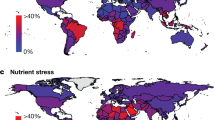Abstract
Based on the discovery of a new epigenetic phenomenon (in the course of implementation of the DIAS program) that consists in changing the range (set) of gene products with respect to the productivity upon changing the limiting factor of the environment, a theory of “ecological-genetic” organization of a quantitative trait is created and developed, from which 20 new biological and quantitatively predictable consequences, 10 forms of practice, and 16 innovative technologies for designing plant varieties with breakthrough yields are derived. With the use of these technologies, four varieties of grain varieties that give a high economic effect have been created. The physical instruments and equipment necessary for more efficient creation of new productive crops are described.
Similar content being viewed by others
REFERENCES
V. A. Dragavtsev, R. A. Tsil’ke, B. G. Reiter, V. A. Vorob’ev, A. G. Dubrovskaya, N. I. Korobeinikov, V. V. Novokhatin, V. P. Maksimenko, A. G. Babakishiev, V. G. Ilyushchenko, N. A. Kalashnik, Yu. P. Zuikov, and A. M. Fedotov, The Genetics of Productivity Traits of Spring Wheats in Western Siberia (Nauka, Novosibirsk, 1984) [in Russian].
V. A. Dragavtsev, P. P. Litun, N. M. Shkel’, and N. N. Nechiporenko, Dokl. Akad. Nauk SSSR 274 (3), 720 (1984).
V. A. Dragavtsev, Biosfera 4 (3), 251 (2012).
E. B. Popov, V. A. Dragavtsev, and S. I. Maletskii, Three Whales of Economics. The Origins and Prospects of a New Direction in General Biology (Izd.-Poligraf. Assots. Vyssh. Uchebn. Zaved., St. Petersburg, 2020) [in Russian].
V. A. Dragavtsev, I. A. Dragavtseva, I. L. Efimova, A. P. Kuznetsov, and A. S. Morenets, S-kh. Biol. 63 (1), 151 (2018).
V. A. Dragavtsev, Byull. Gos. Nikits. Botan. Sada, No. 132, 17 (2019). https://doi.org/10.25684/NBGboolt.132.2019.02
N. P. Krenke, Phenogenetic Variability (Timiryazev Biol. Inst., Moscow, 1933–1935), Vol. 1 [in Russian].
N. A. Plokhinskii, Heritability (Nauka, Novosibirsk, 1964) [in Russian].
W. Williams, Genetic Principles and Plant Breeding (Blackwell Sci., Oxford, 1964).
Z. S. Nikoro, Z. N. Kharitonova, and N. F. Reshetnikova, Different Ways of Determining the Breeding Value of Animals (Kolos, Moscow, 1968) [in Russian].
P. F. Rokitskii, Introduction to Statistical Genetics (Vysheishaya Shkola, Minsk, 1974) [in Russian].
V. K. Savchenko, Genetic Analysis in Network Test Crosses (Nauka i Tekhnika, Minsk, 1984) [in Russian].
P. P. Litun, “Resolution of modern selection schemes,” in Proc. 4th All-Union Congress of the All-Union Society of Geneticists and Breeders Named after N. I. Vavilova, Vol. 2: Plant Genetics (Kishinev, 1982), pp. 89–91 [in Russian].
V. A. Dragavtsev and V. M. Ostrikova, Genetika, No. 8 (4), 33 (1972).
V. A. Dragavtsev, I. B. Pogozhev, and T. A. Sokolova, in Ecosystem Models and Methods for Determining Their Parameters (Comput. Center Sib. Branch Acad. Sci. USSR, Novosibirsk, 1981), pp. 190–196 [in Russian].
V. A. Dragavtsev, Doctoral Dissertation in Biology (Inst. Gen. Genetics, Moscow, 1984).
A. Yu. D’yakov and V. A. Dragavtsev, in Ecological Genetic Screening of the Gene Pool and Methods for Constructing Varieties of Agricultural Plants in Terms of Yield, Resistance and Quality (VIR, St. Petersburg, 1998), pp. 23–40 [in Russian].
V. A. Dragavtsev and E.Ya. Kondratenko, “Genetic analysis of homeostasis of quantitative signs of productivity,” in Abstr. 3rd All-Union Conf. “Ecological Genetics of Plants and Animals” (Kishinev, 1987), p. 136 [in Russian].
V. A. Dragavtsev, I. M. Mikhailenko, and M. A. Proskuryakov, S-kh. Biol. 52 (3), 487 (2017).
V. A. Dragavtsev, I. A. Dragavtseva, I. L. Efimova, A. S. Morenets, and I. Yu. Savin, Tr. Kubansk. Gos. Agrar. Univ., No. 2 (59), 105 (2016).
V. A. Dragavtsev, “Ascertaining of about epigenetic nature of transgressions at plants productivity traits,” in Proc. 5th Int. Conf. “Summer Science Readings,” Kiev, June 31, 2017 (Veles, Kiev, 2017), Part 1, pp. 5–10.
Yu. N. Ivanov, Thoughts on Science and Life, 4th ed. (Svin’in and Synov’ya, Novosibirsk, 2011) [in Russian].
V. A. Dragavtsev and M. M. Rachman, “Problems of forecasting heterosis in quantitative genetics,” in Biometrics in Plant Breeding. Proc. 7th Meeting of EUCARPIA, Norway, 1988, pp. 126–130.
K. Pearson, The Grammar of Science (Walter Scott, London, 1892).
C. Spearman, Am. J. Psychol. 15 (1), 72 (1904).
R. A. Fisher, Trans. R. Soc. Edinburgh 52, 399 (1918).
V. A. Dragavtsev, “The global crisis of crop production of the XXI century requires new technologies for designing breakthrough crop and quality varieties of plants,” in St. Petersburg International Economic Forum (June 2, 2017) [in Russian].
V. A. Dragavtsev and A. F. Aver’yanova, Genetika 15 (3), 518 (1979).
Yu. A. Filipchenko, Genetics of Soft Wheat, 2nd ed. (Nauka, Moscow, 1979) [in Russian].
A. A. Rikhter, Almonds in the Culture of the Crimea (Krymgosizdat, Yalta, 1934) [in Russian].
A. A. Petrosyan, Sb. Nauchn. Tr. Vseross. Nauchno-Issled. Inst. Sadovod., No. 27, 57 (1978).
K. F. Kostina, Breeding in the Southern Zone of the USSR. Selection of Stone Crops (Sel’khozizdat, Moscow, 1956) [in Russian].
G. V. Eremin, Yu. A. Volchkov, and E. M. Garkovenko, Inheritance of Fruit Skin Color by Plum Hybrids (Krasnodarsk. Knizhn. Izd., Krasnodar, 1975), pp. 173–181 [in Russian].
V. A. Dragavtsev, Tech. Phys. 63 (9), 1288 (2018). https://doi.org/10.1134/S1063784218090050
Author information
Authors and Affiliations
Corresponding author
Ethics declarations
The author declares that he has no conflicts of interest.
Additional information
“We are not abandoning plant breeding as an art, but we need a solid, developed, and concrete theory of breeding for certainty, rapidity, and continuity in our work. The team cannot work on the basis of intuition and random luck” (N. I. Vavilov, Teor. Osn. Selktsii [Theoretical Foundations of Plant Breeding], 1935, V. 1, p. 5)
Translated by O. Kadkin
Rights and permissions
About this article
Cite this article
Dragavtsev, V.A. Epigenetics and the Engineering of Plant Varieties with Breakthrough Yield. Tech. Phys. 67, 330–339 (2022). https://doi.org/10.1134/S1063784222050024
Received:
Revised:
Accepted:
Published:
Issue Date:
DOI: https://doi.org/10.1134/S1063784222050024




